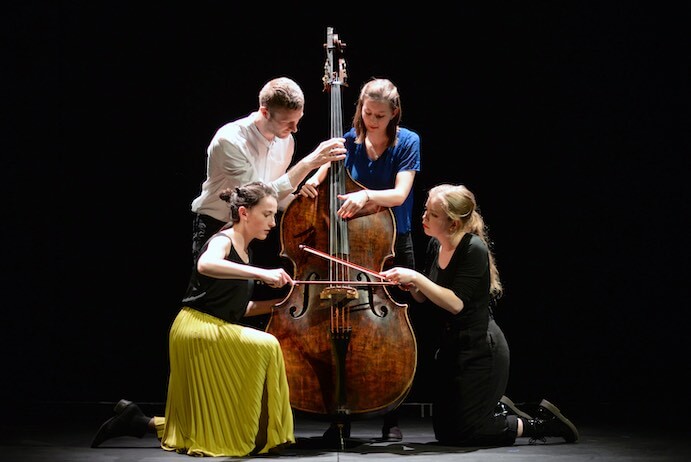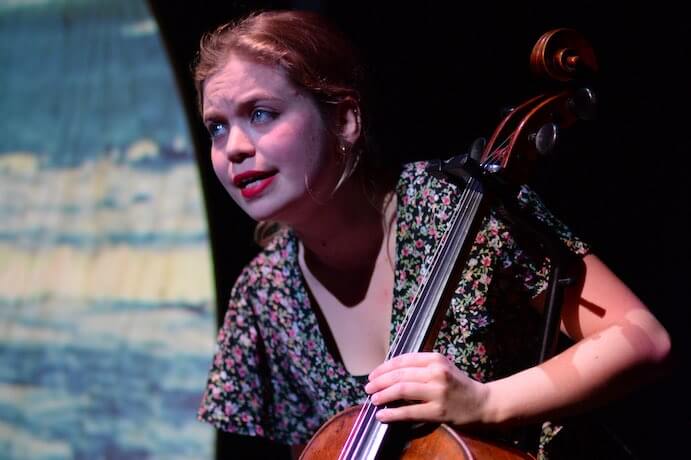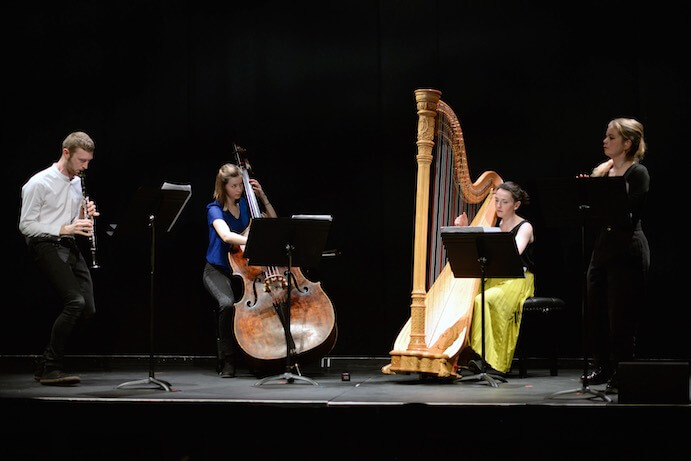On 25 April I went to see an excellent young quartet at Kings Place in London.
Bored already? I’m bored myself by that introduction – there are so many excellent young quartets on the London scene, and few can genuinely claim to be distinctive. But the Hermes Experiment, I promise, is different. It’s a quartet that has carved a niche for itself through its line-up, exploration of different performance styles, and adventurous programmes: it’s experimental by name and by nature.
The four members–Héloïse Werner (soprano), Anne Denholm (harp), Oliver Pashley (clarinet) and Marianne Schofield (double bass)–met at Cambridge University, though their collaboration began after they graduated. In fact, the quartet has a fifth member and co-director, producer Hanna Grzeskiewicz, who is intimately involved with programming and commissioning. The musicians wanted to play together, but as there wasn’t an off-the-shelf repertoire for vocals, harp, clarinet and double bass, they needed to take a different approach. Initially focusing on improvisation, graphic scores, and transcriptions, they have now commissioned over 50 works as their own tailor-made repertoire.
The Kings Place programme, part of the venue’s Venus Unwrapped season (a year-long celebration of female creative artists), featured a graphic score by Mira Calix and an improvisation-led piece for all four members at the double bass, their sonic exploration coupled with striking stage images. Theirs is a wonderful example of an ensemble with friendship and musical affinity as starting points, and since their formation five years ago, they have won several awards and have performed internationally.

The Hermes Experiment: Anne Denholm, Oliver Pashley, Marianne Schofield, and Héloïse Werner–Photo by Emma Werner
But the first half was devoted to Werner’s one-woman opera The Other Side of the Sea, produced by Emily Burns with a text by Octavia Bright and visuals by Jessie Rodger. The stage was empty apart from Werner, her cello, and a large wooden shell-shaped screen on which beautiful and evocative images were projected. A highly personal work, its themes are memory, identity, and dislocation, inspired by Werner’s position as a Frenchwoman resident in the UK and dealing with the cultural and linguistic shifts that involves.
Rodger’s images juxtaposed the sea with fragile flowers, flames, and Werner herself as a child and adult, suggesting journeys and transformation. Fragments of text were repeated regularly–‘Now when you wake you make alien sounds/you dress yourself up in these strange vowels and nouns’–amidst a mélange of the opening of Debussy’s ‘Fantoches’, a Jacques Prévert poem, and extraordinary vocal eruptions of all sorts. As a British woman who is fluent in French and lived for two years in France, the topic resonated strongly with me, though I love making ‘alien sounds’ and feel I have gained new identities, and lost nothing, through learning languages from scratch.
The multi-talented Werner occasionally accompanied herself on the cello, sometimes as a second musical line, sometimes as a sound source when images of the sea were paired with her bowing the body of the instrument in time. It’s impossible not to be reminded of Cathy Berberian’s composition/performance style, with lightning changes of mood, register, and vocal utterance. But as a piece of theatre, the work’s impact was diminished by recordings of work-in-progress discussions about the text which were played in between scenes. The evening’s programme included texts, but not programme notes: I would have preferred these recordings to be replaced by programme notes, and Werner’s excellent diction rendered printed texts unnecessary. The Other Side of the Sea culminated in a poetic final scene, more touching than earlier musings on linguistic identity, and Werner held us in silence before the applause. Ultimately, her performance is what made the work succeed, and music, images and silence proved at least as powerful as words.

Héloïse Werner–Photo by Emma Werner
Werner was joined for the second half by the other members of the Hermes Experiment, and Freya Waley-Cohen’s We Phoenician Sailors, a setting of poetry by Octavia Bright, ensured the programme had a direct link to the opera. This was a conventional text setting, but Stevie Wishart’s 2015 Eurostar – a journey between cities in sound was a soundscape evoking a train journey. The composer was then living in Brussels and travelling there regularly by the Eurostar train from St. Pancras, a station that’s a stone’s throw from Kings Place. Starting from recorded noises of the train and its surroundings, she made an imaginative transformation of these sounds for the quartet (Marianne Schofield demonstrates the bass extended techniques used by Wishart here). Oliver Pashley started with a sheet of paper over the bell of his bass clarinet, producing a fluttery, breathy timbre, and all four performers responded with wit and an aural imagination that matched the composer’s.
I heard the Hermes Experiment premiere Mira Calix’s DMe in 2018 at London’s Café Oto: on that occasion, its graphic score of red, white and black lines was available for listeners to admire. The score transforms Instagram conversations and emojis into visual form, with the musical realisation acting as a further distancing from the original source, though cheeky phrases spoken by all the performers brought us back to the world of online chat. Werner, both vocalist and woodblock player, wore a red T-shirt, as did harpist Denholm: they worked together, opposed by the black T-shirt clad bass pair of Pashley and Schofield. Underpinned by dirty bass clarinet interjections, overlaid by harp and vocal scurrying, this was a tremendously fun piece whose surreal non sequiturs made the audience laugh out loud (‘This is my spoon room’/’This is Northampton’).

The Hermes Experiment: Oliver Pashley (clarinet), Marianne Schofield (double bass), Anne Denholm (harp), and Héloïse Werner (soprano)–Photo by Emma Werner
The fun continued at the close of the programme with Meredith Monk’s Double Fiesta (from her Do You Be album, 1987), arranged by Anne Denholm as a great vehicle for the ensemble, all four members fully at home with Monk’s virtuosity, kooky wit and rhythmic vitality. With them, it became a quadruple fiesta.
The Hermes Experiment are terrific performers and advocates for new music: more than that, they provide a new model for a contemporary music ensemble. They show us that where there is imagination, affinity and a strong desire to communicate and work with composers, music lives and thrives whatever the instrumental medium.























